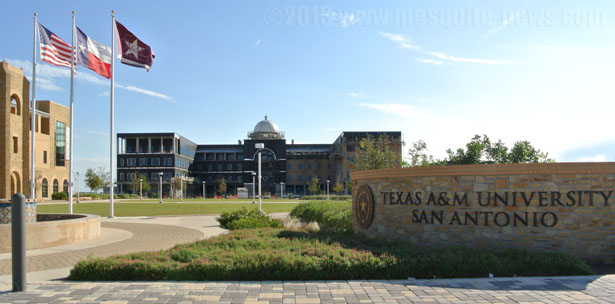
By Jason B. Hogan
The university is proceeding along an accreditation timeline set forth by the Southern Association of Colleges and Schools (SACS), with an accreditation approval predicted for December 2014, said Dr. Holly Verhasselt, assistant vice president for academic affairs.
Verhasselt, who also serves as the SACS liaison for the university’s accreditation team, confirmed Wednesday the university is preparing for an accreditation committee site visit tentatively scheduled for July 2014.
The university submitted an application in July 2012 to the Southern Association of Colleges and Schools Commission on Colleges (SACSCOC), an extension of SACS. The university is currently accredited through Texas A&M-Kingsville and is in the process of seeking separate accreditation.
SACS is one of seven regional accrediting associations operating under the Council for Higher Education Accreditation. The association is appointed to ensure members maintain a high degree of “quality and integrity of higher education institutions and programs,” according to their website. Its primary service area is the southern region of the country, and it is recognized by the U.S. Department of Education.
Applying for accreditation is a four-step process: the pre-applicant workshop, preparation and submission of an application for membership, the candidacy committee visit and the accreditation committee visit.
An institution seeking separate accreditation outside of an already existing SACS member, such as A&M-San Antonio through Texas A&M University-Kingsville, does not require a candidacy committee visit. This allows the university to proceed through the process at a faster rate.
Existing as a branch member of another institution can affect issues like financial aid on the federal level, Verhasselt said. But, since A&M-San Antonio currently falls under the designation of A&M-Kingsville, receiving financial awards for students is not a problem.
Although services are linked with A&M-Kingsville, Verhasselt said there will be no problems with student services once accreditation is achieved.
Once the university is independently accredited, there will be changes in procedure for financial aid and banner operations, Verhasselt said.
In financial aid services, A&M-San Antonio will be capable of administering its own program without going through Kingsville.
As for the banner system, the university is already in the process of rolling out a new portal that will substitute Jaguar Connect, the “one-stop shop” for student services. The transition is seamless enough on the user end that students will not recognize a shift, Verhasselt said.
There are two policies outlined by SACSCOC for the application process for an institution to become an accredited member: “accreditation procedures for applicant institutions and separate accreditation for units of a membership institution.”
A&M-San Antonio falls under the second designation.
The university is dependent upon the decision of the SACSCOC board of trustees in order to become an accredited institution. The board only meets twice a year in June and December.
Accreditation “can take years. It really depends on how quick the institution wants to move forward,” Verhasselt said.
Recognition at the state level as a quality, service-rendering institution is another drawback of not having independent accreditation.
“As far as the (Texas A&M) system is concerned, we are a member,” Verhasselt said. “As far as the federal government is concerned, we are not a separate institution.” But as a branch campus, A&M-San Antonio must answer to its parent institution, she said.
Becoming a separate institution from A&M-Kingsville has very little impact on degree plans and core curriculum at A&M-San Antonio, Verhasselt said.
“Even though we are free from Kingsville we are still responsible to a whole lot of other groups,” she said.
Although that may true, department heads and faculty already have a considerable amount of input on degree plans, Verhasselt said.
Departments will still be guided by system policies for changes in curriculum and degree plans. They are still bound by federal regulations, and are also responsible for submitting requirements to SACS when developing new programs or making curriculum changes.
During an institution’s bid for candidacy and membership to SACS, it cannot undergo any substantive changes which the commission defines as a significant modification or nature- and scope-altering to its service area and programs throughout the process.
Each institution must meet compliance under the commission’s statutes for core requirements, comprehensive standards, as well as federal requirements. The commission considers these requirements basic expectations for institutions seeking candidacy.
The applying institution must also complete a compliance certification.
“Compliance certification is institute driven; writing the narrative and supporting documentation,” Verhasselt said. “This all comes from the institution.”
Once the certification is complete, the process proceeds into the fourth and final step; the accreditation committee visit.
The accreditation team visits the main campus and off site teaching facilities and then submits a report of its findings to the SACSCOC board of trustees for accreditation approval.
“We respond to recommended steps the site team makes,” Verhasselt said. “Ultimately, it goes to the SACS governing board to decide whether we become an accredited institution.”
Texas A&M University-Central Texas announced in June the institution was awarded accredited membership status of SACSCOC.






